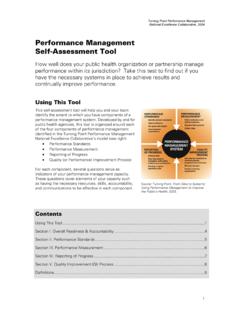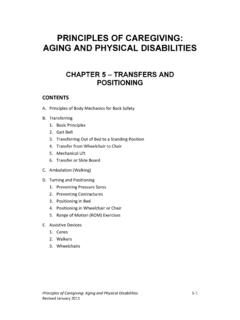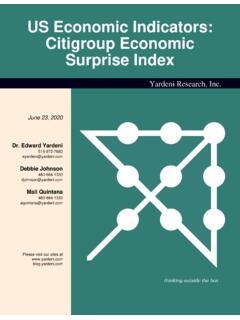Transcription of Turning Nationa y Determined Contributions into action
1 Turning NationalLy Determined Contributions into action FAO support to countries The designations employed and the presentation of material in this information product do not imply the expression of any opinion whatsoever on the part of the Food and Agriculture Organization of the United Nations (FAO) concerning the legal or development status of any country, territory, city or area or of its authorities, or concerning the delimitation of its frontiers or boundaries. The mention of specific companies or products of manufacturers, whether or not these have been patented, does not imply that these have been endorsed or recommended by FAO in preference to others of a similar nature that are not mentioned. The views expressed in this information product are those of the author(s) and do not necessarily reflect the views or policies of FAO.
2 FAO, 2017. FAO encourages the use, reproduction and dissemination of material in this information product. Except where otherwise indicated, material may be copied, downloaded and printed for private study, research and teaching purposes, or for use in non-commercial products or services, provided that appropriate acknowledgement of FAO as the source and copyright holder is given and that FAO's endorsement of users' views, products or services is not implied in any way. All requests for translation and adaptation rights, and for resale and other commercial use rights should be made via or addressed to FAO information products are available on the FAO website ( ). and can be purchased through Introduction The phenomena associated with climate change, such as higher temperatures, rising sea levels and the increased frequency of floods and droughts all have negative impacts on the agriculture sectors (crop and livestock production, forestry, fisheries and aquaculture).
3 These impacts threaten food security severely. Already today, about 815 million people suffer from hunger, and as the global population grows, the need for food will increase (FAO, IFAD, UNICEF, WFP and WHO, 2017). To ensure sufficient and healthy diets for all, today and tomorrow, the world needs to scale up climate action in the agriculture sectors. To meet the challenge of climate change, the international community reached a landmark deal at the 21st Conference of the Parties (COP21) of the United Nations Framework Convention on Climate Change (UNFCCC) in Paris 2015. In adopting the Paris Agreement, which was a result of a country-led process that built on national commitments, countries have assumed a lead role in combating climate change. Different countries have different capacities to respond to changes, and some will need more support than others to turn their commitments into action .
4 As the specialized UN agency leading the global promotion of sustainable development in the agricultural sectors, FAO is offering support to countries during every stage of the process planning, implementing, monitoring, reporting and revising to fulfil national commitments. FAO is augmenting this work as a member of the NDC Partnership, a new global initiative to help countries achieve their climate commitments. The main aim of the Paris Agreement is to curb the effects of climate change by limiting the increase in global temperatures to well below two degrees Celsius and, if possible, substantially lower. To reach this ambitious goal, countries have made individual climate commitments, referred to as Intended Nationally Determined Contributions (INDCs). These proposed actions were communicated ahead of the Paris Agreement and served as a basis for the negotiations.
5 As countries ratify the Paris Agreement, the INDCs are converted into Nationally Determined Contributions (NDCs), unless they choose to submit new more ambitious commitments. Countries are then required to submit revised NDCs every five years. So far, the targets countries have set to limit emissions are not enough to keep global warming below the two degrees Celsius threshold (Rockstr m et al., 2017). To achieve the aims of the Agreement, it is crucial that countries become consistently more ambitious in their proposed targets when revising their NDCs. The agriculture sectors stand out as a priority in the INDCs, as demonstrated in FAO's analysis of the Agriculture Sectors in the Intended Nationally Determined Contributions . This study shows that the agriculture sectors are expected to play a significant role in national responses to climate change.
6 This is particularly true for developing countries where agriculture sectors are vital for safeguarding livelihoods, food security and nutrition. The priorities outlined in the NDCs provide the framework for climate change collaboration between FAO and countries, and are reflected in the Organization's new climate change strategy. Many countries have recognized that responding to climate change and achieving sustainable development go hand-in-hand. This connection is emphasised in the strong links with the Paris Agreement and the 2030 Agenda for Sustainable Development and its 17 Sustainable Development Goals (SDGs). FAO, as a custodian agency for over twenty SDG indicators, also supports countries in their efforts to achieve the SDGs. This brief summarizes FAO's analysis of NDCs and provides an overview of how the Organization, through policy processes, capacity development and technical interventions on the ground, supports the implementation of NDCs in the agriculture sectors.
7 Prioritizing agriculture sectors Global warming has a profound impact on all agriculture sectors. At the same time, these sectors make significant Contributions to greenhouse gas (GHG) emissions. Both mitigation and adaptation actions are crucial for protecting and enhancing global food security and nutrition, and achieving sustainable development. In their commitments to combat climate change, countries have recognized agriculture's double significance. Thirty-nine percent of all developing countries have identified food insecurity and malnutrition as among the major risks they face as a result of climate change. The agriculture sectors are among the main priorities in countries' mitigation Contributions and adaptation objectives. For more than half of all countries, 61 percent, agriculture has a clear role to play in achieving mitigation and adaptation goals.
8 The agriculture sectors have significant potential to reduce GHG emissions. This fact is also reflected in many countries' commitments. Nearly 90 percent of all countries and 86 percent of all developing countries refer to crop and livestock production and/or land use, land-use change and forestry when outlining their mitigation Contributions . Among the developing countries that specified adaptation commitments or actions in their INDCs, more than 90 percent of them linked these commitments to the agriculture sectors. The changes that food producers can make to adapt to climate change can also bring about emission reductions and removals. Many countries have acknowledged the potential adaptation-mitigation synergies that exist in the various agriculture sectors and have recognized that tapping into these synergies can deliver valuable economic, environmental and social co-benefits.
9 Climate-Smart Agriculture (CSA) has been highlighted as an approach that contributes to both adaptation and mitigation. Thirty-two countries, including 40 percent of the least developed countries, refer to CSA in their INDCs. 2. Climate Change Strategy In April 2017, FAO endorsed its corporate climate change strategy. It articulates a vision of food and agricultural systems and livelihoods that are made more resilient to the impacts of climate change through measures that both facilitate adaptation to change and realize their mitigation potential. FAO's support to the implementation of NDCs is at the heart of its corporate climate change strategy. The climate change strategy guides FAO actions toward achieving three mutually reinforcing outcomes: 1. Enhanced capacities of countries on climate change through FAO leadership as a provider of technical knowledge and expertise.
10 2. Improved integration of food security and nutrition, agriculture, forestry and fisheries considerations within the international agenda on climate change through reinforced FAO engagement. 3. Strengthened coordination and delivery of FAO work on climate change. The NDCs present a framework for the Organization's work on climate change. They define, at the highest political level, the targets and strategies for responding to the impacts of climate change and addressing its root causes. FAO programmes must respond to the challenge of climate change in the broadest possible context by engaging with regional and global agendas, bridging short- and long-term timeframes, being climate-smart and working across sectors and with all stakeholder groups. This composite approach to climate change is fully consistent with the objectives of the SDGs, adheres to the FAO principles for sustainable food and agriculture (FAO, 2014) and serves to sharpen the climate perspectives of existing FAO social and environmental policies.

















